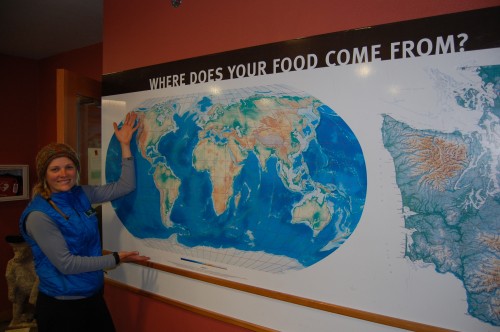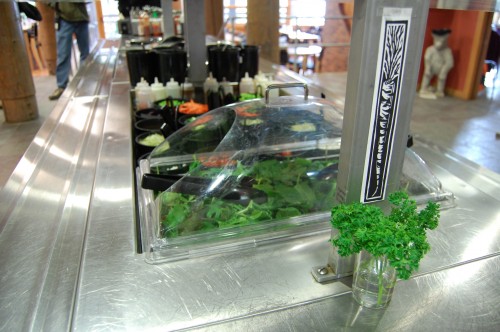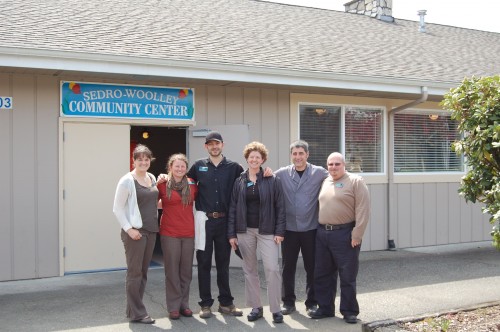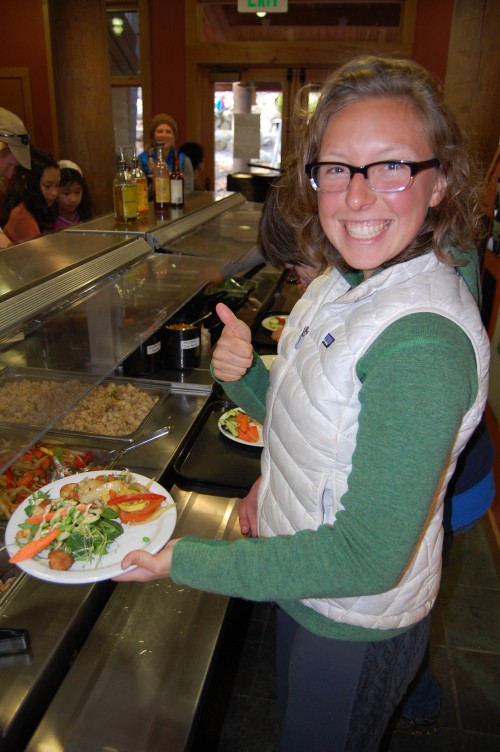Edible Geography: Perspectives and Practice in Foodshed Education

With an Introduction Recounting Current Happenings in the Foodshed Project
[We are excited to publish the fifth piece in our Foodshed series, with monthly updates from the amazing chefs working hard to provide program participants and staff at the Environmental Learning Center with sustainable, seasonal, and deliciously fresh food. In an age where the production and consumption of food are heavily disconnected, North Cascades Institute works hard to preserve those ties by considering how food flows from the farms to our tables and all the processes in between. Purchasing from local farmers allows us to draw connections between their livelihoods and our own while at the same time contributing to our mission to conserve Northwest environments through education. It’s a renewing and rewarding partnership, and one we are committed to sustaining and growing. Learn more about our Foodshed Initiative.]
Summer is peeking around the corner at the Environmental Learning Center. We’re beginning to see some fresh local products coming through the door, including radishes and fresh spring greens from Blue Heron Farm. We received our first cooler full of pasture-raised chickens from Osprey Hill Farm two weeks ago, and there has been the comforting sight and smell of stock simmering on the stovetop on several occasions since.
Last weekend we hosted Molly Hashimoto’s Printmaking and Watercolor class and what a lovely crowd. It’s fun to share what we do with artists because they appreciate so much attention to detail. The only difference is that their work is going to last a lot longer than the Evergreen Sorbet we made for desert.
 Chris Kiser, a graduate student who participated in the printmaking workshop, even made us a bit of food-inspired eye candy for the salad bar (a carrot).
Chris Kiser, a graduate student who participated in the printmaking workshop, even made us a bit of food-inspired eye candy for the salad bar (a carrot).
This week we continued treating the Mountain Schoolers to our best efforts, as well as sponsoring a luncheon for the Chamber of Commerce in Sedro-Woolley on Wednesday. We served pasture-raised chicken and Tillamook smoked cheddar crepes with a Washington apple glaze, grass-fed Swedish meatballs and gnocchi with garlic-cream sauce, local grilled asparagus and some of those greens and radishes from Blue Heron Farm with nettle & honey vinaigrette. We received a warm greeting and more than a few compliments from the local business owners in Sedro-Woolley. A good day!
 North Cascades Institute staff members Jessica, Codi, Mike, Amy, Shelby, and Jason livin’ it up in Sedro-Woolley!
North Cascades Institute staff members Jessica, Codi, Mike, Amy, Shelby, and Jason livin’ it up in Sedro-Woolley!
In terms of our Foodshed, the chefs estimated that about seventy to eighty percent of the ingredients were local, and that’s pretty good work. Cutting, pulling, rendering fat, and making stock from twelve whole birds is definitely not like throwing some boneless, skinless chicken breasts on the grill. But that is the work we do here and we enjoy it.
So after loading up 700 pounds of organic flour and chatting with Kevin Christenson at Fairhaven Mills in Burlington, we headed back to the Environmental Learning Center to find chef Rusty serving up some yummy stir-fry for the Mountain School crowd.
 Graduate student Kiira Heymann is happy. But you already knew that.
Graduate student Kiira Heymann is happy. But you already knew that.
In short, things are looking up and life is good here at the Environmental Learning Center. If you want to keep reading, the next section is a short essay I wrote called “Edible Geography.” The recent Sourdough Speaker Series with John Scurlock really got me thinking about the link between geography and food and the following is what I have been mulling over.
Edible Geography
It’s hardly a secret that food is necessary, but if necessary can be fun, why not? The authors of “Coming Into the Foodshed,” a 1996 article in the journal Agriculture and Human Values, claim that globalization has largely succeeded at distancing the production and consumption of food (1). Author of Slow Food Nation Carlo Petrini suggests that the industrialized West has also witnessed and allowed a distancing between ourselves and our own kitchens (2). So we are left to consider that “Big Food” (a lá Food, Inc.) is big because it is doing work that we cannot or will not do ourselves. One way that we can reassert ourselves is to follow this advice: Cook! A lot. Try to have fun doing it, and share. The rest will come naturally (and maybe organically)!
If you watch television (and I rarely do) you would think the whole world has gone food-crazy (Confession #1: I watch Iron Chef sometimes). There is this celebrity chef thing going on big time. They are making emulsions and gels. They are infusing your marmalade (rhymes with “Todd”). They are putting cuts of meat inside little bags of plastic and putting them into… wait for it… hot water. Seattle’s Nathan Myrhvold recently published Modern Cuisine; it’s got six volumes and is 2,438 pages long. I have not read it, but somebody probably is reading it right now. And even if you are not down with cooking in a plastic suit or learning the metric system, there is still a freshly baked cookie sitting on the counter for you, and it is the presence of a genuine and considerably popular interest in all things food.
That leaves unresolved how something can be so popular and yet so absent. The sink is full of dirty plates and we are eating out a lot (do not deny it). It’s like: what is the deal? Don’t we want to go all Mario Legasse and throw the salt and pepper all around? BAM!!! Why is the most frequent complaint about cooking that it takes too long but we are watching several hours of television every day? (You are right: TV is more fun than doing dishes). And we are shelling it out for satellite smart phones so we can go facebookin’ all over the place and we are going to complain about a sixty-five cent premium on carrots that don’t have chemicals on them? Seriously?! I have to agree with the notion that the distance in our modern food system has left us ‘disempowered’ (3) and that actually cooking, not just watching other people cook on television, is the ticket.
The Farm-to-Table movement has brought much deserved attention to growing, buying, and eating food, but I want to bring attention to that hot mess between the farm and the table: the kitchen (4). Most everybody has got one, and it is the place where we can meet the challenge of continually restoring ourselves while adjusting our cultural attitudes to embrace sustainability. Our willingness to prepare raw, fresh food shapes our choices, and those choices affect markets as well as the people, soil, and animals that depend on them. Our individual agency in the food system is often described in economic terms; buy this thing and not that thing. But economics is a poor ideological template for something that is necessary and irreplaceable. The school of thought that rationalized “credit default swaps” musn’t be trusted with food. Food is culture (5); culture is change. We cannot talk about ‘changing the economy’ (or anything else) without talking about food. It is the door and window to our cultural mindset, meaning it is something that allows us to see as well as move through barriers into a new space.
[SCENE:] Seattle resident Ken Jennings snickers with satisfaction as he opens up a copy of John Scurlock’s Snow & Spire: Flights to Winter in the North Cascades to discover a map of Western Washington on the inside cover [HOLD THAT THOUGHT].
Confession #2: I received a signed copy of John Scurlock’s book for my birthday in mid March. And though I had spent a lot of time with the pages open, it was not until I was trying to smarten up for the author’s April speaking engagement at the Environmental Learning Center that any earnest reading occurred (sorry, John, just being honest). I mean, a whole coffee-table book full of aerials in that brilliant Cascadian palette on big glossy pages?! It is my birthday! But I encountered in this visual masterpiece a literary talent. And I was humbled, not only by the writing, but by the overwhelming epiphany that the Foodshed Project and Scurlock’s work share the same basic impetus. All we are trying to do is get a little perspective.
At first, relating aerial photography to the work of the kitchen staff at North Cascades Instititute seemed liked a stretch, given the fact that he is piloting a homemade aircraft alone over the remote and jagged peaks of the snow-plastered North Cascades in the dead of winter, and we are cooking. It was difficult to compare the successful expansion of horizons with the ongoing struggle to reduce our ‘footprint.’ But for me the common ground is now stunningly clear: it’s geography!
Now about Ken Jennings… He’s a Jeopardy! champion and recent author of Maphead: Charting the Wide, Weird World of Geography Wonks. (OMG, he is like, super smart). He says maps are “critical to the way we think. If maps didn’t exist, it would be necessary to invent them” (6). In a way, maps summon our desire to fly like a bird and see the world from above. We crave perspective, we yearn for a visceral sense of topography, we want to see and feel places that we have never been. The richness of maps can inform in a unique and powerful fashion. To call them ‘educational’ would be a drastic understatement. So basically the Foodshed Project proves that Ken Jennings is right: a comprehensive map for a better food system does not yet exist, so here we are trying to invent one. We are attempting to fuse our desire to map our world with the desire to eat better. Like Scurlock, we are looking out the window to get a feel for the landscape.
Both airplane flight as well as a globalized food system offer what Scurlock refers to as “cartographic freedom.” But here is the twist: the Foodshed Project is about trying to perceive the quantity of distance but also the quality of proximity. Written right into the original goals of North Cascades Institute’s Foodshed Project is the charge to “prioritize local foods, though they may cost more, require extra logistical effort and increase preparation time” (“Foodshed Project Goals” 2003). It is in plain writing that this organization has made a commitment not just to the economic but the practical culinary implications of sourcing local food. I think that is the key innovation, and it can be an inspiration for our own practice. If we are going to “eat local” and allow proximity to inform our selection of raw ingredients, we are led directly to the alchemy of cooking. Doing it with passion and purpose enables us to not only reduce our environmental impact but to restore pleasure and beauty to one of our most basic tasks: feeding ourselves.
Many of our “traditional” foods are products of regions and climates that might be a half a world away from our current locations. “What we call culture,” writes Massimo Montanari from his book entitled Food is Culture “takes its place where tradition and innovation intersect” (7). But many of the “innovations” that have occurred in our modern food system are aimed at making things faster and easier. This is not necessarily a bad thing; we do need to eat. It is when industrialization occurs not only in the landscape and the economy but the mind as well that we see trouble. As long as we are concerned with just how quickly it can happen and how little effort is required, we are cheating ourselves out of real gratification.
I feel like the idea of “gastronomy” has the connotation of snobby-ness. But here is a definition anybody could agree with from Carlo Petrini: “Gastronomy enables us to live the best life possible using the resources available to us and stimulates us to improve our existence” (8). This definition is simple and durable and innovative because it places the possibility of fulfillment within limits. Explained this way, it seems like the natural fit for meeting the challenge of eating local. Our perspective is geographic, our practice is culinary, and our culture can be one of health, sustainability and happiness.
Confession #3: I love Ratatoullie, both the movie and the dish. The dish because it is yummy, the movie because it presents a critique of haute cuisine and says: “anyone can cook.” And it is true. Everybody can perform the alchemy of cooking, and it gives us confidence and cultural identity. It strengthens our desire to know where our food is grown and builds respect for people, animals, plants and soil (a.k.a. “the environment”). Simple, right?
SOURCES
(1) Kloppenburg, Jr., John, John Hendrickson and G.W. Stevenson, 1996. “Coming into the foodshed.” Agriculture and Human Values, 13:3 (Summer); pp. 33-42.
(2) Petrini, Carlo (2005). Slow food nation. Rizzoli Ex Libris, NY; p. 78.
(3) Kloppenburg, et al.
(4) Two important disclaimers: First, I’m definitely not saying that the kitchen is the most important part of the Farm-to-Table process. It’s just overlooked more often as people look for ‘legitimate’ economic or political solutions. While not the entirety of our food experience, cooking is right in the middle of it. Second, I’m not claiming to be some big-time cheffy-pants. I just like to cook.
(5) Montanari, Massimo (2004). Food is culture. Columbia Univ. Press, NY.
(6) Jennings, Ken (2011). Maphead: harting the wide, weird world of geography wonks. Scribner, NY; p. 26.
(7) Montanari (2004); p. 7.
(8) Petrini (2005); p. 56.
Shameless promotion: Please check out a video I made with my family for the My Coop Rocks Video Contest, and VOTE for our video, “The Skagit’s Got The Stuff.” You can vote everyday to help us win and give the Skagit Valley some nationwide pride!
[Leading photo: Our awesome blog editor Chris Kiser goes all Vanna White on the Foodshed Map. All photos courtesy of the author.]

